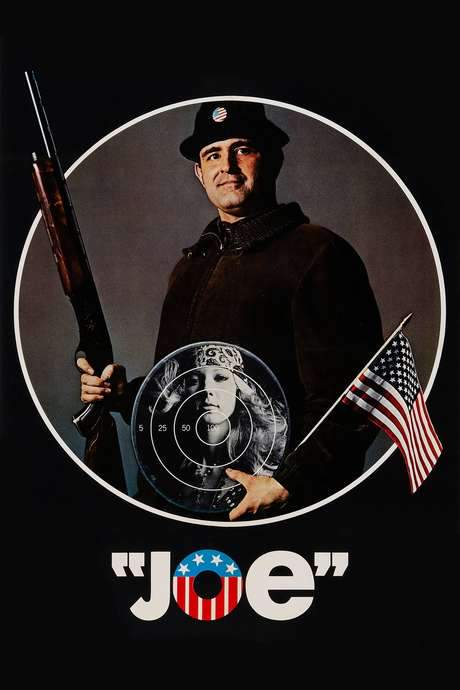
Joe
Year: 1970
Runtime: 107 mins
Language: English
Director: John G. Avildsen
After killing his daughter’s drug‑dealing boyfriend, a wealthy advertising executive wanders into a seedy bar and forms a tense partnership with Joe Curran, a volatile, drunken factory worker whose bigoted views and violent tendencies make him a dangerous ally. Their uneasy collaboration unfolds against a grim, decaying American landscape, echoing the slogan “Keep America beautiful.”
Warning: spoilers below!
Haven’t seen Joe yet? This summary contains major spoilers. Bookmark the page, watch the movie, and come back for the full breakdown. If you're ready, scroll on and relive the story!
Joe (1970) – Full Plot Summary & Ending Explained
Read the complete plot breakdown of Joe (1970), including all key story events, major twists, and the ending explained in detail. Discover what really happened—and what it all means.
Advertising executive Bill Compton Dennis Patrick and his wife Joan Compton Audrey Caire are a wealthy couple living on the Upper East Side of New York City. Their perfect, polished life is shaken when their daughter, Melissa Compton Susan Sarandon, has been living with her drug-dealing boyfriend. The tension between appearances and reality quickly comes to a head when Melissa overdoses and is rushed to a hospital, throwing the family into crisis mode and forcing Bill to confront a brutal truth about his daughter’s life.
After Melissa’s hospitalization, Bill goes to the apartment of her boyfriend, Frank Russo Patrick McDermott, to recover Melissa’s belongings. In a moment of terrible rage, he confronts Russo and shoots him, killing him. In an attempt to cover up the crime as a robbery, Bill stuffs a bagful of drugs into his car and departs, hoping the evidence will vanish amid the city’s shuffle. The act leaves him shaken, yet strangely buoyed by a grim sense of control. To steady his nerves, he stops by a nearby bar and runs into Joe Curran [Peter Boyle], a factory worker whose blunt, almost philosophical hatred of hippies is on full display. In a tense moment of bravado and self-deception, Bill tells Joe he killed a hippie, a claim Joe initially takes as a boast but quickly senses is more complicated than it appears.
What begins as a chance meeting soon spirals into a dangerous bond. A few days later, Joe and Bill reconnect, this time under the pretense of cautious camaraderie. Joe proposes nothing concrete beyond mutual reassurance, but the two men slowly discover a private rapport forged in fear, guilt, and shared complicity. The situation becomes more perilous when Melissa secretly overhears a conversation between her parents about the murder and confronts Bill, demanding accountability. The scene crystallizes the family’s unraveling and Nycity’s cold, indifferent reach into private violence.
“What are you gonna do, kill me too?”
Melissa’s defiant question signifies a turning point that shifts the story from a tense private tragedy into a public, chaotic free-for-all. Melissa escapes from the hospital and returns to the family apartment, where she presses her father for answers and exposes the widening rift between her parents. The tension between Bill, Joan, and Melissa intensifies as the adults attempt to manage the fallout of the crime, while Melissa’s insistence on truth becomes increasingly precarious.
The trio’s search for Melissa drives them into the street-level heart of downtown Manhattan, where they encounter a group of hippies at a bar and are invited into the hippies’ shared living space. The mood shifts from uneasy civility to a reckless, drug-fueled interlude. The men bring drugs into the encounter, and the women—still young and searching—engage in reckless sexual play that mirrors the moral dissolving of the adults’ world. In the aftermath, the hippies steal Bill’s drugs and both men’ wallets, leaving them emotionally raw and materially stripped.
Determined not to be outpaced by chaos, Joe guides Bill toward a rough, almost dangerous sense of justice. They eventually head toward a nearby upstate commune, arming themselves with rifles as a grim warning that violence will continue to march forward. A tense confrontation erupts at the commune, where old loyalties fracture and fear-heightened instincts take hold. Joe fires first, and Bill—despite his earlier attempts to maintain control—ends up joining in the shootout. In the chaos, a devastating truth comes to light: Melissa herself becomes a casualty of the night’s cascading violence, killed by the very man who tried to shield her from the consequences of his crime.
Throughout the narrative, the film threads a chilling meditation on guilt, desire, and the seductive lure of moral compromise. The Upper East Side veneer of prosperity collides with a counterculture underbelly that grows increasingly invasive, while the central trio of Bill, Joan, and Melissa is drawn into a cataclysmic sequence of choices that push each character toward a stark, irreversible end. The performances from the principal cast—Bill Compton [Dennis Patrick], Joan Compton [Audrey Caire], and Melissa Compton [Susan Sarandon]—anchor a story that moves from a private tragedy to a citywide crisis, challenging viewers to weigh the cost of keeping up appearances against the consequences of the acts people justify in the name of protection, loyalty, and fear.
Last Updated: October 07, 2025 at 09:22
Unlock the Full Story of Joe
Don't stop at just watching — explore Joe in full detail. From the complete plot summary and scene-by-scene timeline to character breakdowns, thematic analysis, and a deep dive into the ending — every page helps you truly understand what Joe is all about. Plus, discover what's next after the movie.
Joe Timeline
Track the full timeline of Joe with every major event arranged chronologically. Perfect for decoding non-linear storytelling, flashbacks, or parallel narratives with a clear scene-by-scene breakdown.



